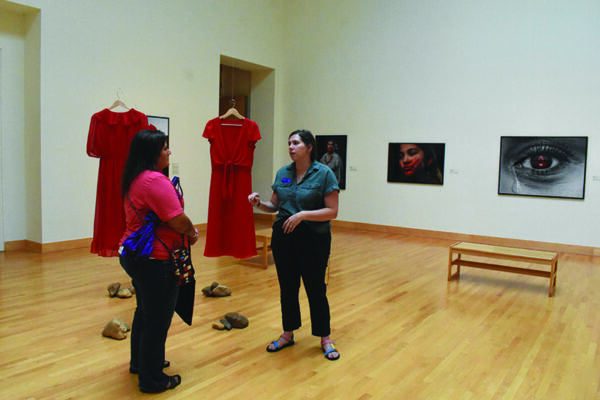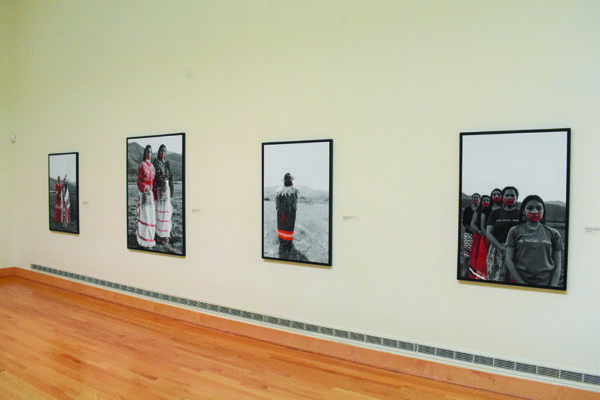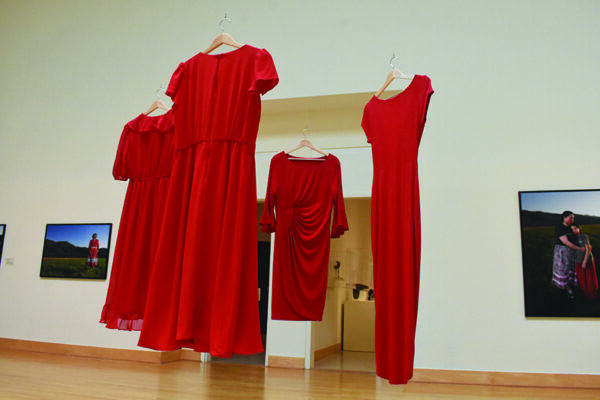By JONAH LOSSIAH
One Feather Staff
Keep saying her name, and she’ll never disappear.
Western Carolina University’s (WCU) Fine Arts Museum is now displaying a new exhibition that highlights art of the Missing and Murdered Indigenous Women (MMIW) movement.

Sky Sampson, left, director of the Cherokee Center, discusses the new MMIW exhibit with Rachel Hood, marketing manager of the Bardo Art Center. (JONAH LOSSIAH/One Feather photos)
“We Will Not Be Silenced” is the primary display in the WCU Fine Art Museum Fall series and will run until Dec. 9. Sky Sampson, director of the Cherokee Center at WCU, said that it has been a unified effort with her office, the Bardo Arts Center (BAC), and the artists involved in the project.
“I wanted to do something impactful that would be a connection between Western and the Tribe (Eastern Band of Cherokee Indians). Everybody that you see in these pictures has some kind of connection to the Tribe or Western or both. We did invite, first and foremost, alumni and students, community members, and staff,” said Sampson.
The exhibit has been much more involved and encompassing than Sampson originally thought. She simply wanted to offer a platform to continue the messaging of the MMIW movement.
“We knew we wanted to do a small exhibit. We had an event coming up and it was for the multicultural mental health showcase this year. Our original plan was very small. We were going to get these printed on some foam boards and put them up at a session. While we were at the site taking photos, we were all talking about it. I came up with the idea of making a bigger exhibit. A couple of other people were like, ‘yeah, we could even travel it’. I was like oh my gosh, that’s an awesome idea!”
Sampson said that the current project didn’t really take shape until WCU became a partner in the effort. The university covered the bill for the entire project and will be a big part of operations if the exhibit manages to become mobile.
“We first wanted to establish the exhibit here. Western’s whole staff here, they agreed. We were actually going to put it back as a smaller exhibit for the semester. But because mental health and wellness is the campus theme this year, that’s why we wanted to do this.”
Rachel Hood, marketing manager for the BAC, said that it was an easy decision to get involved in the project. She said that she has been blown away by the power of the art, movement, and response.
 “We really want to focus on showing the different cultures of western North Carolina. This is part of western North Carolina. Let’s get some focus onto something that’s happening right now. This isn’t something that was just happening a couple of years ago and now it’s solved. It’s something that’s actively still going on. So, let’s figure out how we can talk about that,” said Hood.
“We really want to focus on showing the different cultures of western North Carolina. This is part of western North Carolina. Let’s get some focus onto something that’s happening right now. This isn’t something that was just happening a couple of years ago and now it’s solved. It’s something that’s actively still going on. So, let’s figure out how we can talk about that,” said Hood.
Both Sampson and Hood stated how important it has been to approach the directive from all angles. Social media has become a useful tool for the movement as well.
“I was introduced to this through TikTok. I had read a book, “Fire Keeper’s Daughter”. It seems that TikTok just listened to what I had been listening to and I heard about the movement. For a while, I was just in this hole of seeing all these women and these people with red handprints on their faces. That sparked me to learn more,” said Hood.
Denise Drury Homewood, executive director of the BAC, said that she couldn’t be happier with the process so far. She just wants to applaud the individuals involved and do what they can to promote and assist the movement.
“We’re thrilled. To partner with Sky, the artists, and to be able to bring this here. I feel with our mission and one of our focus areas in the collection and exhibition is highlighting Native American and Indigenous artists through contemporary art,” said Homewood.
Homewood said that this is definitely not the last exhibit that will put indigenous art at the forefront.
“This is not a one-off for us. We collect and interpret contemporary Native American art. Back in 2017, that’s when we were introduced to Jeff Edwards’ (a Cherokee Nation artist) work. When we partnered with Sky, other members of the Tribe, and other artists to bring that exhibition to campus. And we had a symposium. So, we had artists from these tribes that were ancestrally located in the Southeast coming together with Eastern Band artists, and it was the coolest symposium.”
Sampson said that she has appreciated WCU’s efforts to properly include Cherokee voices on campus. She said that it was not always so easy. She remembers when she was a student at the university and feeling much more isolated. Sampson said that it’s important to continue forward while keeping in mind the relatively new partnership between WCU and the EBCI.
“The biggest thing we want to do when people come here is education. We offer EBCI training. You can get a seal when you’re done and put it up on your door. That kind of shows that ‘hey, they know how to work with the Tribe.’ It gives me a chance to sit down with them,” said Sampson.
 She said that many people at WCU and in the region don’t truly know about daily life in Cherokee or the direction of the Tribe. She also said that she has been impressed by the attitudes of those that work with the Fine Arts Museum. Hood reinforced this idea, stating that is exactly what Homewood has implemented in the department.
She said that many people at WCU and in the region don’t truly know about daily life in Cherokee or the direction of the Tribe. She also said that she has been impressed by the attitudes of those that work with the Fine Arts Museum. Hood reinforced this idea, stating that is exactly what Homewood has implemented in the department.
“She’s very passionate about creating an avenue but letting someone who has the knowledge be the person who brings this to life. Because me and her, we are not EBCI. So, we’re not going to try to speak for you,” said Hood.
“They don’t want to just check a box. They actually want to develop those relationships and build on those every year. Think outside the box,” said Sampson.
Sampson also wanted to ensure that each of the artists involved in the project were highlighted. The six artists and photographers were:
- Ashley Evans
- Dylan Rose
- Moe Hernandez
- A. Johnson
- ᏥᏳ Chi Myriah Shipman
- Jamie Black
Following the exhibit’s run until Dec. 9, Sampson and the Fine Arts Museum hope and plan on offering it out to other art museums. Talks are still in the early stages, but the idea is to focus first on local offers in the region and state. Sampson and Hood said there is already interest in picking up the exhibit.
A reception for this exhibit is scheduled for Wednesday, Nov. 2 from 5 p.m. to 7 p.m. at the Fine Arts Museum.
“This exhibition, ‘We Will Not Be Silenced’, is just a continuation of our dedication to highlighting contemporary Native American artists. We’re thrilled to continue that,” said Homewood.
The WCU Fine Art Museum exhibitions and events are free and open to the public. Standard Museum hours are Tuesday through Friday 10 a.m. to 4 p.m., and Thursday 10 a.m. to 7 p.m. For any questions, call (828) 227-ARTS.
More information on “We Will Not Be Silenced” and the Bardo Arts Center can be found at https://www.wcu.edu/bardo-arts-center/. Institutions interested in hosting the exhibit can direct inquiries to Sky Sampson at snsampson@email.wcu.edu.


